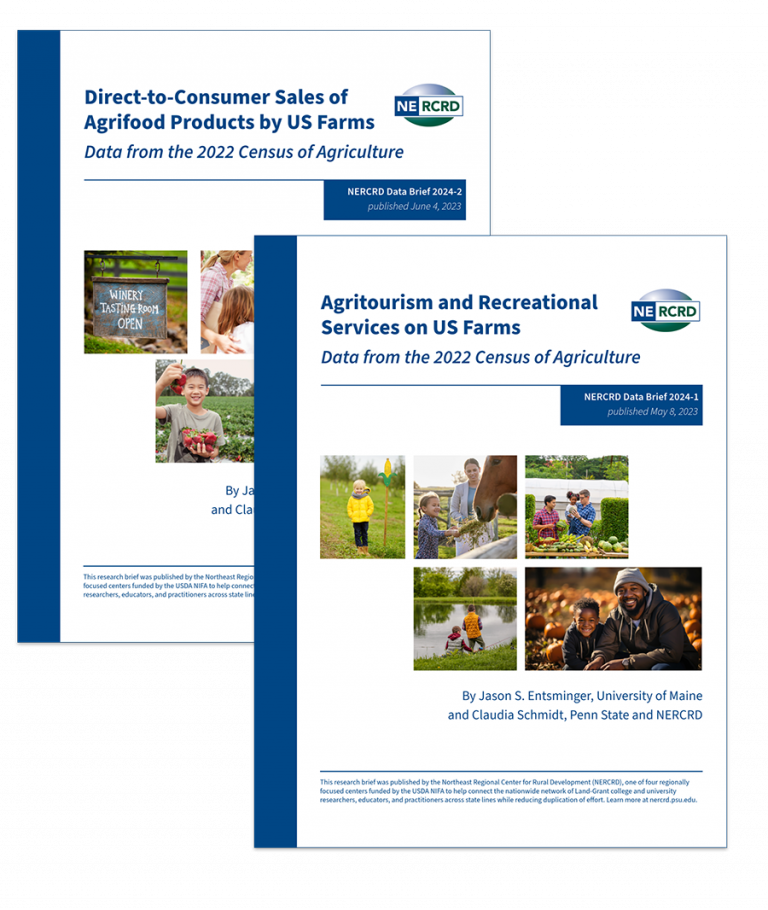
New data briefs document recent changes in U.S. agritourism and direct-to-consumer sales sectors
June 4, 2024
Researchers from the University of Maine and Penn State have released a set of comprehensive data briefs that shed light on two small but important sectors of U.S. agriculture — agritourism and direct-to-consumer sales — utilizing data from the 2022 Census of Agriculture. The briefs, published by the Northeast Regional Center for Rural Development, provide valuable insights into the current status of these sectors and also document recent trends, both nationally and for each state.
For this analysis, agritourism refers to farms that welcome visitors to their operations to engage in on-farm experiences, including recreational services. Direct-to-consumer sales refers to sales made directly to customers without going through an intermediary, and only includes edible products.
Of the 1.9 million U.S. farms estimated in the 2022 Census of Agriculture, 1.5% reported being engaged in agritourism and 6% had direct-to-consumer. However, data shows these activities are a significant source of income, accounting for combined receipts of more than $4.5 billion in 2022. Much of that went to small and medium-sized producers, according to the study’s lead author, Jason Entsminger, University of Maine assistant professor of entrepreneurship and innovation and assistant extension professor and small business specialist.
“Our analysis of these newly released data indicates that agritourism and direct-to-consumer sales are critically important sources of revenue for America’s small family farms” Entsminger said. “We know that entrepreneurial marketing strategies which welcome visitors to the farm or engage the consumer directly may help producers create and capture unique value right at home in their rural communities.”
In their agritourism analysis, the researchers found that roughly 28,600 U.S. farms and ranches reported receiving income from agritourism or on-farm recreation services, and that, on average, these operations earned $44,000 in gross revenue from their agritourism ventures. The total income generated from agritourism and recreational services nationally grew by almost $310M since the 2017 Census of Agriculture, totaling roughly $1.26B in total gross receipts. Despite this 33% increase over a five-year period, the number of farms offering these activities remained relatively static.
In their analysis of direct-to-consumer sales, they found that 116,617 agricultural operations sold food or drink products directly to consumers, which marked a 10.3% decrease since the 2017 Census of Agriculture. On average these operations generated $27,981(gross) in direct sales, an 8% increase over 2017 averages when adjusting for inflation. The gross value of products sold directly by farms to consumers across the nation reached $3.26 billion.
In addition to providing statistics about the number of operations and sales generated, each data brief examines differences across farm size and economic class for the nation. Each also examines key indicators at the state level, shedding new light on how agritourism and direct-to-consumer sales are dispersed geographically across the U.S.
Agritourism and direct-to-consumer sales often go hand-in-hand, for example when winery visitors purchase a bottle of wine after touring the vineyard. Data on prior years from the more detailed Local Foods Marketing Practices Survey by USDA indicates that 50% or more of the total value of direct-to-consumer sales is captured via transactions immediately on U.S. farm properties. However, the researchers analyzed agritourism and direct sales separately due to a data limitation, according to Claudia Schmidt, an assistant professor of marketing and local and regional food systems at Penn State and a NERCRD faculty affiliate.
“The Census questions about agritourism and on-farm recreational services are separate from questions about on-farm sales,” said Schmidt. “As a result, our first brief focuses only on the experiential forms of agritourism, for example farm tours, hayrides, and hunting or fishing and does not include data regarding on-farm activities that have a direct-sales component, such as ‘pick-your-own’ activities or farm stands. However, we captured these activities in our second brief, which also includes data on direct-sales made off-farm, such as those made at farmers markets or directly to restaurants.”
The researchers utilized data from the 2022 Census of Agriculture, which was released earlier this year. The USDA’s National Agricultural Statistics Service conducts the Census every five years, inviting every known agricultural producer in the U.S. to complete a detailed questionnaire about their farm’s demographics, economics, land use, on-farm activities, and more.
Sarah Cornelisse, a Penn State senior extension program specialist, also contributed to this research, which was funded by the USDA National Institute of Food and Agriculture (NIFA).
The research briefs were published by the Northeast Regional Center for Rural Development, one of four regionally focused centers funded by the USDA NIFA to help connect the nationwide network of Land-Grant college and university researchers, educators, and practitioners across state lines while reducing duplication of effort.
